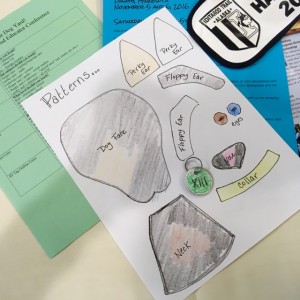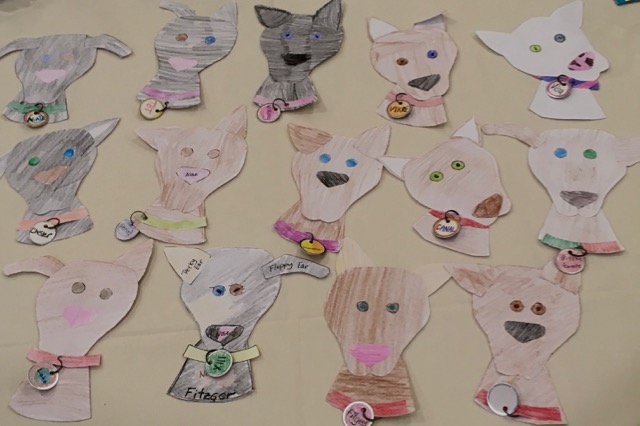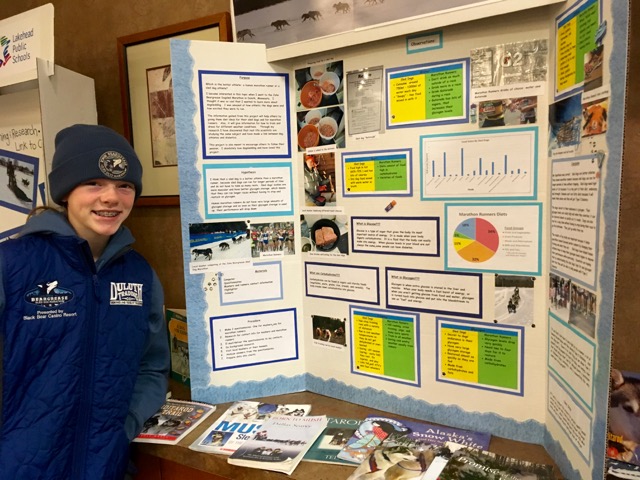Duluth, Minnesota was the site of a conference in early November where educators gathered to learn more about the education programs and resources of Iditarod and the John Beargrease Sled Dog Marathon. Educators far and wide know that sled dog based real life applications captivate and motivate students. This is the first time the two races have teamed up to share their educational resources, culture and history with teachers from the lower 48 states as well as Canada.
Lessons using the theme of sled dogs in the classroom can be found on both the Iditarod and Beargrease web pages. Multiple standards based lessons were shared at the conference giving teachers ideas to take and implement in their learning environments.
A glyph warm-up activity led by Jen Reiter introduced conference participants to each other. Glyphs are a way of sharing information without words. It’s also a tremendous exercise in listening and doing. Reiter provided a sheet with the nose, eyes, ears, face, neck and collar of a dog. The parts were colored and assembled according to the following questions – where are you from, what subject do you teach, what level do you teach, what is the role of sled dogs in your classroom, what is it about sled dogs in the classroom that intrigues you and what are you hoping to take home from the conference. After answering the questions by coloring and assembling a dog, teachers compared glyphs and used the information to collaborate with like-minded others. Reiter has created a resource that can be found on the Iditarod Education Portal, Mathing Down the Trail. These ready to take to your classroom activities bring the Iditarod and mushing into your math curriculum year round.
Iditarod and the John Beargrease Sled Dog Marathon share many common attributes but also have many unique characteristics. Unique to each is the trail and length of the race. The 1,000-mile Iditarod runs from Anchorage to Nome through land that is unspeakably beautiful, unthinkably rugged and inconceivably challenging. Once Iditarod teams leave the starting line in Willow, there is no road access to checkpoints. Airplane, snow machine or dog team is how people move from village to village in the winter. The mushers have sent supplies ahead to checkpoints on the trail. The nearly 400-mile Beargrease runs from Two Harbors, Minnesota, paralleling the north shore of Lake Superior to Grand Portage then returns down the shore and finishes a few miles north of Duluth. Beauty, challenge and ruggedness abound along the trail. Beargrease mushers face the challenge of steep climbs and ascents in the Saw Tooth Mountains of northern Minnesota. Unique to the Beargrease are road accessible checkpoints. Team handlers can drive to the checkpoints and support their team at most, but not all checkpoints.
As to the question about which trail is more difficult, Iditarod or Beargrease, one could ask any number of mushers who’ve run both races. Nathan Schroeder from Chisholm, MN has completed three Iditarod runs and has taken Beargrease gold in ’10, ’13, ’14 & ‘16. Other Beargrease Champions that would be able to compare the trails include Jason Barron, Keith Aili, Mark Black, Blake Freking, Cliff Wang, Frank Teasley, John Barron, Jamie Nelson, Doug Swingley, Terry Adkins, Susan Butcher, DeeDee Jonrowe, Myron Angstrom, Robin Jacobson and John Patten. Between all of these folks who’ve won the Beargrease and also completed Iditarod, there could be many different opinions on which trail is more difficult and which race is harder. Nathan Schroeder weighed in on the question saying, “The Beargrease trail is harder. It’s up hill and down hill over short choppy hills for 300 of the 350 miles of the race. The dogs have a hard time getting into a rhythm. Iditarod is a tougher race simply because everything gets thrown at you.”
Jen Reiter, 2014 Iditarod Teacher on the Trail™, took conference attendees down the trail with Iditarod 101. She spoke about the history of Iditarod including what motivated Joe Redington Sr. to found the race. As Joe saw more and more snowmachines and fewer and fewer sled dogs in the villages of Alaska, he conceived the idea of Iditarod in order to preserve the sled dog as well as it’s place in Alaska’s history and to preserve the historic Iditarod trail.
Beargrease President, Jean Vincent, continued the 101 session by introducing the Beargrease trail, speaking about its unique nature and sharing information about the Beargrease organization. Beargrease is an entirely volunteer based organization with the exception of a sponsor coordinator and the trail boss. Roughly 500 volunteers gather each year to make the Beargrease race happen. The trail covers a distance of 360 miles with 2,000 feet in elevation changes through the Sawtooth Mountain Range, one of the oldest ranges in the US. The Beargrease runs along the north shore of Lake Superior between Duluth and Grand Portage, MN, covering much of the same trail up bound and down bound. The Beargrease sponsors a Junior Race as well as a Cub Race. Vincent says these races for young aspiring mushers fulfill their mission statement.
Linda Fenton, 2013 Iditarod Teacher on the Trail™, shared Social Studies mushing related activities she uses in her elementary classroom. Fenton believes in using sled dogs to motivate kids. She says, “The impact that the theme of Iditarod has on learners is tremendous.” Linda also shared mushing themed STEM activities. One of her favorites is a genetics based lesson using a trait wheel. Fenton’s lessons including a large collection of her social studies based lessons can be found on the Iditarod Education Portal.
Mike Keyport, great-grandson of John Beargrease shared the history of John and the Beargrease race. Mike currently serves on the Beargrease Board of directors as Vice President. It’s the first time in the thirty-three year history of the race that a Beargrease family member has been on the Board of Directors. John Beargrease, of Ojibwe descent, grew up on the shores of Lake Superior. He was educated by the land, the lake and his elders. John and his brothers hunted up and down the shore. Many people asked if they’d be willing to carry a parcel to someone along the shore during their travels. When the hooked up with the postal service, they became the official mail carriers between Duluth and Grand Portage. In the winter they used the “trail” and traveled by dog team. In the summer they went by boat on Lake Superior. GPS was very simple back then. They counted paddle strokes and streams they passed to know exactly where they were.
When people began talking about a race in the Arrowhead of Minnesota, they had a lot of decisions to make – type, length, trail and what to call it. It was determined the race would be a marathon or 300-400 miles, the route would follow the old mail trail and then somebody suggested naming the race after the old-timer, John Beargrease, who carried mail along that trail. Mike says, “ The Board of Directors has never forgotten who this race is named after and has kept it very cultural.” As a mail carrier, John is known for many great feats not the least of which is making the distance (roughly 200 miles) between Two Harbors and Grand Marais in just 28 hours with a loaded sled pulled by 4 dogs.
Katie Mangelsdorf, author of Champion of Alaskan Huskies, connected with the conference via SKYPE to share the story of Joe Redington, Sr. and his quest to save the Historic Iditarod Trail and the Alaskan Husky. Redington, a dreamer and a doer proposed the 1,000-mile race. Joe’s dream grew into The Iditarod Trail Sled Dog Race which some consider to be the most demanding and famous sled dog race in the world.
Junior Musher Julia Cross has been on the runners for eight years and has her sights on the Junior Iditarod and in the future, Iditarod. Julia has competed in the Jr. Beargrease, the Beargrease Cub Run and the Dog Days of Winter 7-mile Race. Cross has chosen to incorporate sled dogs into her life as a student through project based learning. She displayed and explained her projects at the conference. One of her extensive projects focused on determining which was the better athlete, a human marathon runner or a sled dog athlete. She created questionnaires for mushers and for marathon runners, did background research, compiled data, analyzed data and presented her findings to support her hypothesis. It was a complex question that required extensive time and investigation.
Conference attendees also heard from hands on dog people – mushers and a veterinarian. Nathan Schroeder, a three-time Iditarod finisher and four-time Beargrease champion, shared his experiences from both trails. Ryan Anderson, who will run his rookie Iditarod in 2017, has won Beargrease gold twice. Both men are Minnesota mushers and have dominated the Beargrease since 2010. Beargrease head veterinarian Gregg Phillips shared information on how the canine athletes are kept healthy on the trail. The Beargrease veterinarian team consists of vets from Minnesota, Wisconsin, Arizona, Tennessee, Maryland and Canada. Phillips says, “Although our career paths are diverse, we share a love for sled dog racing and a desire to provide veterinary guidance to mushers and veterinary care for extraordinary canine athletes.”
In a closing session, Jen Reiter and Rebecca Cross connected the Iditarod and the Beargrease through Trail Mail. It’s obvious that the two races are connected as sled dog races. There are a host of other similarities that aren’t so obvious. Beargrease is a highly respected Iditarod qualifying race, both races have rest requirements and both race routes follow mail trails used long ago. Reiter shared lessons she has prepared for the Smithsonian Institute on Trail Mail. Cross shared the Beargrease Trail Mail project that allows kids to send letters that will be carried on the trail. Prior to the start of each race, Beargrease mushers actually take an oath to be mail carriers. Reiter and Cross also took the teachers down a rich technology trail of Beargrease and Iditarod based lesson. Each race has standards based lessons banked on their web page for teachers to adapt for use in their classrooms. Use this link to enter the Iditarod Education Portal. This link will redirect you to the Beargrease Education web page.
As an additional resource, the 2017 Iditarod Teacher on the Trail™, Annie Kelley, SKYPED into the conference. Annie invited teachers to follow her blog now as well as during the race. Currently, Annie who lives and teaches in Chicago, is posting ready to use standards based classroom activities and lessons. When she is on the trail during Iditarod, she’ll be posting daily, connecting classrooms around the world to the mushers and dogs as they traverse the Historic Iditarod Trail from Anchorage to Nome.




































